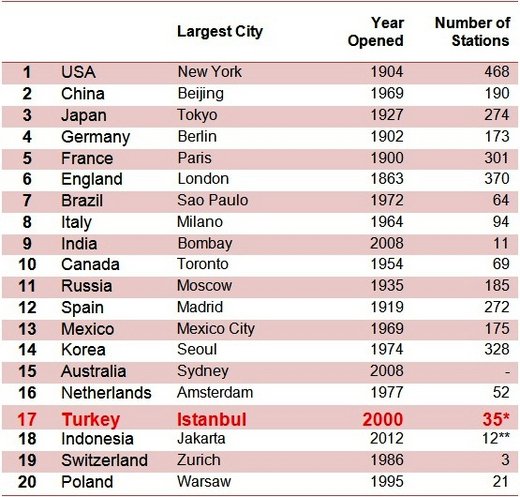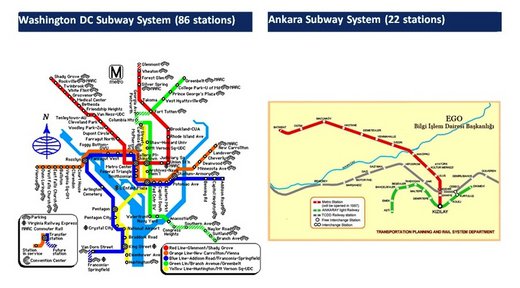TEPAV Articles
- [Archive]
Are women in our cities not working because of insufficient subway systems? 09/01/2012 - Viewed 3341 times
There is a debate we have missed out on due to the tumultuous agenda of the week: The Mayor of the Istanbul, Kadir Topbaş, said that the dolmuş (a shared transportation system where the rate is paid by the distance traveled) will gradually be retired from city traffic. On the day this remark was made, a few news channels asked the opinion of regular people on the streets but then the matter was completely forgotten. This, however, is an issue of great importance on Turkey’s path to becoming a normal country.
Economic transformation demands that goods and services are constantly replaced by more efficient ones. We have seen many examples of this: supermarkets have replaced small shops, for instance. Through we have been aware for the last 149 years that rail systems are more efficient than dolmuş for local transportation, we have not started to build subway systems until recently (The half-kilometer Karaköy-Tünel route in Istanbul is an exception. The second subway system ever to be built, it was opened in 1875. The London subway, the first such system, was opened in 1863.)
The table below shows data on the subway systems of the top twenty economies of the world including the date of their opening and the number of stations. I think it is partially possible to explain why Turkish women do not participate in the labor force by considering these two indicators. Since I am an expert on neither labor markets nor transportation, however, I will just state a few observations on subway systems and then ask some questions about the link between such systems and female labor force participation.
It is planning, not finance, that is needed to construct subways. The Istanbul subway system was opened in 2000, more than a century later than those in almost all of developed cities. I can hear some of you saying, “Those are rich countries. They had the means to build subway systems, we did not.” But please explain to me how Sao Paulo opened its subway system in 1972, Mexico City in 1969, and Seoul in 1974, three decades before Istanbul. It appears that we have done something wrong. We have confused the notion that the “economy cannot be managed with plans” with that of “cities cannot be managed with plans.” As you might have noticed, the squatter neighborhoods (gecekondus) and the dolmuşization of urban transportation coincided with this period of confusion. The economists of this country pondered macro issues such as inflation in the last century. I am wondering how many bothered to think about urban economics. After all, constructing an underground subway system requires a vision, a strong ability for planning and, of course, the political and financial power to realize the plan. You decide which ones Turkey lacked (or is lacking).
To become one of the top 10 economies of the world, Turkey has to monitor the number of subway stations closely in the period ahead. The number of stations is probably a subway system’s chief indicator of the economic contribution to a city. Consider each station as a district. How many districts benefit from the advantages of a subway system? Can people travel to work and back home safely and cheaply within a foreseeable timeframe, without suffering traffic? New York has 468 districts benefiting from all of the above. Seoul has 328. The number of lucky districts in Istanbul is only 12, comprising people who live close to the subway stations between Taksim and Hacıosman. When the subway system on the Anatolian side, which is currently under construction, is opened, the number of lucky districts will reach 35. But what about those living in other districts? If they are lucky, they can use the light rail system or the metro bus. Otherwise, they will spend 10 to 25 percent of their lives in their two-square meter cars (even F-type jail cells are bigger). Oh, and some people in this country actually live in cities other than Istanbul. Myself, for example: I live in Ankara, which has a 22-station subway. The distance on foot between my home and the nearest station is 50 minutes, and that between my office and the nearest station is 35. I would walk anyway, but there are no sidewalks to walk on! (Please see http://www.tepav.org.tr/en/kose-yazisi-tepav/s/2962)
Going back to the main point, I believe there is a strong relationship between the insufficiency of the urban subway systems in Turkey and the low rate of employment among women. According to the experts on the issue, the lack of improvement in the female labor force participation rate in Turkey remains a puzzle.[1] Urbanization and education rates have been increasing and the fertility rate has been decreasing. The level of employment among women, however, has not risen as much as expected. Although the rate of employment is high among urban women with university diplomas, the labor force participation rate is extremely low among women with educational attainment at or below high school. I think a part of this puzzle (probably a large one) relates to the dolmuş system and the lack of a sufficient subway system.
I have not come across a scientific study that would let us reach a concrete conclusion on this question. But I would like to ask, in which language other than Turkish is a form of sexual harassment named after a dolmuş brand? Would the female labor force participation rate be any different if Turkey had made a significant attempt at building subway routes in its large cities during the 1970s and 1980s? Would a girl newly graduated from high school have a different perspective about working if she had the chance to travel from her home to the most distant location of the city with a 1.5 Lira ticket, fast and safe, while she was sitting and reading and not abused (like not hearing “could you please pass the money to the driver”)? I think it would affect her decision positively. Please write to me if you think otherwise. And please take the subway from Taksim to Hacıosman at 8:30am and return to Taksim with a dolmuş.
To cut a long story short, when it comes to getting more women to participate in the labor force, enabling them to commute to work with cheap, fast and safe transportation is as important as offering them education. If you do the latter but neglect the former, the only winners will be the producers of the awkward morning and afternoon programs on television.
Table: Number of Subway Stations and Subway Opening Year in the Largest 20 Economies of the World

Source: Wikipedia (*The Istanbul subway currently has 12 active stations, 23 are under construction; **Jakarta has 12 stations under construction and the system is planned to be opened in 2012.)
Footnote: I hope one day when we visit the website of the Ankara Metropolitan Municipality we will see an illustration of a subway system like that of Washington DC instead of weird photographs (Please see the chart below).
Chart: Map of subway routes in Washington DC and Ankara
Esen Çağlar, TEPAV Economic Policy Analyst, http://www.tepav.org.tr/en/ekibimiz/s/1025/Esen+Caglar
[1] http://siteresources.worldbank.org/TURKEYEXTN/Resources/361711-1268839345767/Female_LFP-en.pdf















